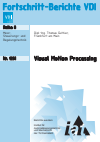Visual Motion Processing
Zusammenfassung
The capability to recognize biological motion, i.e. gestures, human actions or face movements is crucial for social interactions, for predators, prey or artifcial systems interacting in a dynamic environment.
In this thesis an artifcial feed-forward neural network for biological motion recognition is proposed. Like its natural counterpart, it consists of multiple layers organized in two streams, one for processing static and one for processing dynamic form information. The key component of the proposed system is a novel unsupervised learning algorithn, called VNMF, that is based on sparsity, non-negativity, inhibition and direction selectivity.
In the frst layer of the dorsal stream, the VNMF is modifed to solve the optical flow estimation problem. In the subsequent layer the VNMF algorithm extracts prototypical patterns, such as optical flow patterns shaped e.g. as moving heads or lim parts. For the ventral stream the VNMF algorithm learns distict gradient structures, resembling edg...
Schlagworte
- Kapitel Ausklappen | EinklappenSeiten
- 1–11 1 Introduction 1–11
- 89–115 5 Feature Extraction 89–115
- 126–131 7 Conclusion 126–131
- 132–132 A Bag of Words 132–132
- 133–134 B Visual Cortex 133–134
- 135–136 C Gradient Derivations 135–136
- 143–158 Bibliography 143–158


